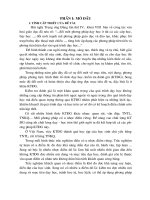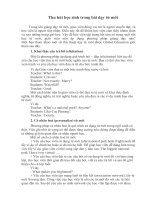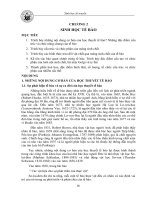- Trang chủ >>
- Đại cương >>
- Kinh tế vĩ mô
Sinh học tế bào tiếng Anh
Bạn đang xem bản rút gọn của tài liệu. Xem và tải ngay bản đầy đủ của tài liệu tại đây (579.26 KB, 1 trang )
<span class='text_page_counter'>(1)</span>SH02003: CELL BIOLOGY (SINH HỌC TẾ BÀO) Credits: 2 credits (Lecture: 2 – Practice: 0) EXPECTED LEARNING OUTCOMES Expected learning outcomes of program. COURSE EXPECTED LEARNING OUTCOMES After successfully completing this course, students are able to. Course objectives. Knowledge CELO1 CELO2. Explain the specific biological structures and processes that take place in cells; cell cycle and cell cycle control.. ELO1, ELO4. Applying knowledge of cell biology to explain the scientific basis of several issues related to fields of biotechnology, ELO1, ELO4. biomedicine, environment, and food technology . Skills CELO3. Detecting and solving several problems related to fields of biotechnology.. ELO6. CELO4. Do teamwork and organize effectively teamwork.. ELO7. Personal autonomy and responsibility CELO5. Proactively study, accumulate knowledge to improve capacity and professional qualifications. ELO15. CONTENT. STUDENT TASKS. Chapter I: An overview of the cells. • Attendance: Students are required to attend at least 2/3 of the total theory lectures of the course.. Chapter II: Cell-membrane systems Chapter III: Transport of substances across biological membranes Chapter IV: Cytoskeletal system and cellular dynamics Chapter V: Cell cycle and the control of the cell cycle.. LEARNING METHODS • Read lecture notes, books and references before attending the class. •. Listen to lectures in class. •. Perform other learning activities such as answering questions, doing exercises, discussing in groups.. Triacetylchitotriose. Colloidal chitin. Diacetylchitobiose. • Preparation for the lecture: Students are required to read lecture notes, textbooks and references before attending the class. • Group discussion and presentation: Students are required to engage in group discussion. • Mid-term exam: Students miss a mid-term will be given a mark of zero. • Final exam: Students must take the final exam and meet requirements. • For online learning: Students need to install online learning software and fulfill the requirements for online learning.. ASSESSMENT METHODS 1. Scale: 10 2. Weighting: The course mark is the sum of the rubric scores multiplied by the respective weight of each rubric - Class attendance: 10% - Discussion: 10% - Mid-term test score: 20% - Final exam: 60%. LECTURERS 1. Ph.D. Bui Thi Thu Huong. 0968092528, 2. Assoc. Prof. Dong Huy Gioi 0983671218, 3. Ph.D Nguyen Thi Thuy Hanh, 0968210990,
<span class='text_page_counter'>(2)</span>









